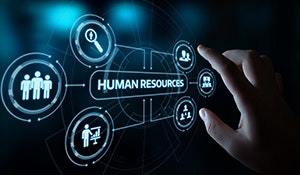Information embedded in traditional paper-based documents and files has limitations in terms of longevity, accessibility and security. Although HR departments of many companies have been migrating a part of this information to spreadsheets and Word documents, they are still saddled with operational challenges. While some succeed in digitising a large amount of data, others manage to achieve complete automation.
When it comes to technology, every HR has to choose what works best for their organisation. But it’s always safer to revisit the basics before getting started with anything new. That’s because ambiguity at a critical juncture could turn out to be costly. This post is targeted at HR professionals who have been seeking better clarity on the differences between automation and digitisation.
What is the difference between automation and digitisation?
HRMS automation is the process of deploying and using software tools to automate, streamline and simplify manual tasks and workflows that are usually considered repetitive and laborious by both HR and employees.
Digitalisation is the process that involves the conversion of physical information (paper-based documents) into common digital formats, like text, image and audio, which can be read and processed by computers.
What are the benefits of automation?
Improved efficiency
Repetitive, manual tasks can slow down the HR function and others who are dependent on it, fully or partially. Automation optimises and expedites processes and enables faster sharing of information for more jobs to be done faster in a shorter span of time. HR will also have more time for more value-added tasks and initiatives.
Minimised errors
To err is human! But more human intervention could result in more errors. Also, the physical processing of documents can make tasks appear to be mundane and taxing when the workload increases. Here’s where machines have an edge! Today’s HRMS software companies design software tools that are programmed to perform certain jobs quickly, accurately and consistently.
Reduced costs
Automation doesn’t mean that machines will completely take over the work of humans. It just means that the existing workforce can be utilised better for what they are good at doing. It can also improve manpower planning since HR will know exactly, well in advance, how many people they need to hire. Smart hiring and job allocation will result in time and resource optimisation besides reduction in manpower costs.
Improved employee experience
Employees shouldn’t be made to wait! They need time and energy to do what is expected from them. If they are made to spend too much time on basic HR tasks, like requesting salary slips and leave balance reports, they can get demotivated. The result? Higher attrition rates. That’s not a good sign for the organisation. Today’s HRMS platforms, with built-in self-service features, make each of these tasks not only easier but also enjoyable.
An employee self-service portal/app allows employees to access information, make requests and perform basic HR tasks without reaching out to the HR department.
Easier compliance
Paper-based documentation makes the tasks of statutory reporting and data privacy management cumbersome. Non-compliance can lead to hefty penalties and a sullied reputation. HR automation platforms make the reporting process automatic and hassle-free. Moreover, many of these platforms are built to be compliant with the major data privacy laws.
What are the benefits of digitisation?
Cost savings
Wastage often goes unnoticed, especially when it’s not tracked. It is even harder to store, retrieve, print and track information that resides on physical/paper-based documents.
They are also vulnerable to accidents and natural calamities. All of this adds to the costs incurred by the business/HR department. Digitisation can eliminate all these concerns.
Instant access to information
Chaos happens when documentation is disorganised. When documents are digitised and organised online, anyone can access them from anywhere. Since HR and employees spend less time searching for the same, productivity will eventually skyrocket.
HR can store employee records, policies, forms and letters online, so that any employee in the organisation can access the same anytime on any device.Many HRMS apps offer ready-to-use templates that can be customized.
Insightful analysis
When the right insights are not available on time, decision-making gets hampered. What’s more, decisions based on assumptions make matters worse. Advanced analytics tools help collect, analyse and visualise disparate data faster than manual methods. Improved visibility and real-time access to insights make it easier to make course corrections and process improvements at various stages.
Enhanced data security
Loss, theft and misplacement of records are commonplace in the physical world. HR, in particular, has sensitive personal information that cannot be compromised at any cost. But its probability is higher in the current scenario, where more devices and more data lie outside the perimeter of the physical office. Modern HRMS platforms have a robust security layer to handle this threat. Some of these platforms have a multilayered encryption system to help protect critical data.
Summing up
Most of the HR functions can be digitised and automated. But the decision to switch depends on multiple factors like the nature of business, core objectives, scale of operations, level of tech know-how and existing IT infrastructure, to name a few. Budget is certainly a decisive factor, but today’s cloud-based HRMS systems have made digitisation and automation affordable even to small and medium businesses.
A job well done is always a job well planned. If you are planning to take that big leap, make sure that you have taken these steps: Decided the processes to be digitised/automated, ensured leadership support, trained the HR team and educated the workforce in a phased manner.
If you are expected to tread carefully, you could digitise/the essential HR functions first and then upgrade gradually at a later point in time. Even the choice between the two depends on the objectives of HR and the leadership. We all know that HR has transformed into a strategic function that is aligned closely with the business functions. Therefore, HR knows what will work best for the organsiation. No doubt, the support of IT, finance and other functions are indispensable.









